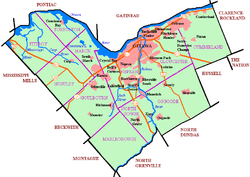Kanata
| Kanata | |
|---|---|
| Community | |

Three-metre-high sign at Kanata's eastern boundary
|
|
| Location in Ottawa | |
| Coordinates: 45°20′N 75°54′W / 45.333°N 75.900°WCoordinates: 45°20′N 75°54′W / 45.333°N 75.900°W | |
| Country |
|
| Province |
|
| Municipality | City of Ottawa |
| Incorporated | 1978 |
| Amalgamated | 2001 |
| Government | |
| • Mayor | Jim Watson |
| • City councillors | Allan Hubley, Marianne Wilkinson, Eli El-Chantiry |
| • Member of Parliament | Karen McCrimmon |
| • Member of Provincial Parliament | Jack MacLaren |
| Area | |
| • Land | 132.21 km2 (51.05 sq mi) |
| In 2001, at time of dissolution | |
| Population (2011) | |
| • Community | 80,781 |
| • Urban | 101,760 (population centre) |
| Time zone | Eastern (EST) (UTC−5) |
| • Summer (DST) | EDT (UTC−4) |
| Postal code FSA | K2L, K2M |
| Area code(s) | 613, 343 |
| Website | http://web.ncf.ca/aj624/kanata.html |
Kanata is one of the largest suburbs of Ottawa, Ontario, Canada. Located about 22 km (14 mi) west-southwest of the city's downtown, Kanata had a population of 80,781 (population centre: 101,760) as of 2011 and is growing rapidly. Before it was amalgamated into Ottawa in 2001, it was one of the fastest growing cities in Canada and the fastest growing community in Eastern Ontario. Located just to the west of the National Capital Commission Greenbelt, it is one of the largest of several communities that surround central Ottawa. It is a planned community and an important hi-tech centre.
The area that is today Kanata was originally part of the Township of March, and was first settled by Europeans in the early nineteenth century. One site dating from this era is Pinhey's Point.
It remained mainly agricultural until the 1960s when it became the site of heavy development. Modern Kanata is largely the creation of Bill Teron, a developer and urban planner who purchased over 1,200 hectares (3,000 acres) of rural land and set about building a model community. Unlike other suburbs, Kanata was designed to have a mix of densities and commercial and residential properties. It contained large amounts of open space, and was to be surrounded by a greenbelt. A reflection of the garden city movement, the area was divided into a series of communities, each of which was intended to have its own commercial centres and unique cultures. These include Beaverbrook, Glen Cairn, Bridlewood, Katimavik, Hazeldean, Morgan's Grant, and Kanata Lakes. The first street to be built was Tiffany Crescent in 1964.
...
Wikipedia

